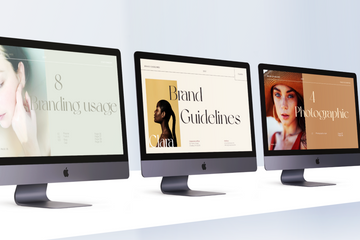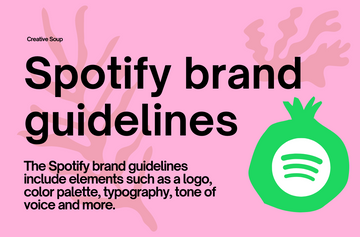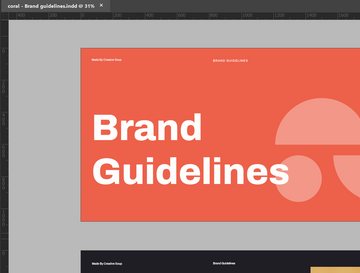Introduction
In today's competitive market, maintaining a consistent and professional brand image is crucial. A well-crafted brand guidelines template PPT format can serve as a vital tool for ensuring that your brand is represented consistently across all channels. This guide will walk you through creating a comprehensive brand guidelines template, covering all essential aspects from logo usage to typography, color schemes, and more.
Understanding Brand Guidelines
Importance of Brand Guidelines Brand guidelines are essential for maintaining a cohesive and professional image across all marketing materials and communications. They ensure that everyone in your organization, as well as external partners, understands how to represent your brand correctly.
Key Components Brand guidelines typically include information on logo usage, color schemes, typography, imagery, and brand voice. These elements work together to create a unified and recognizable brand identity.
Benefits of a Brand Guidelines Template A well-designed template simplifies the process of creating and updating brand guidelines. It ensures that all elements are consistently presented and easy to follow, saving time and reducing the risk of errors.
Getting Started with Your Template
Selecting the Right Software PowerPoint is an excellent tool for creating brand guidelines templates due to its versatility and ease of use. Other options include Adobe InDesign and Canva, depending on your design skills and preferences.
Creating a Structure Start by outlining the key sections you need to include. This will serve as the backbone of your template and ensure that all important aspects of your brand are covered.
Customizing the Layout Design a clean and professional layout that aligns with your brand’s aesthetics. Use consistent margins, fonts, and colors to create a visually cohesive document.
Brand Identity Elements
Logo Usage Include guidelines for the correct usage of your logo. This should cover different variations, such as full color, black and white, and icon versions.
Color Palette Define your primary, secondary, and tertiary colors, including their HEX, RGB, and CMYK values. This ensures that colors are consistently used across all media.
Typography Specify the fonts that should be used for headings, subheadings, and body text. Include guidelines on font sizes, line spacing, and alignment.
Imagery Describe the style of images that should be used in your branding materials. This could include guidelines on subject matter, composition, and any specific treatments or filters that should be applied.
Voice and Tone
Brand Messaging Outline the key messages that your brand should convey. This includes your mission statement, values, and any taglines or slogans.
Writing Style Define the style of writing that should be used in your communications. This could include guidelines on sentence structure, vocabulary, and punctuation.
Tone of Communication Specify the tone that should be used in your communications. This could range from formal and professional to casual and friendly, depending on your brand’s personality.
Logo Guidelines
Logo Variations Provide examples of different logo variations and when to use each one. This could include full color, monochrome, and simplified versions.
Safe Space and Sizing Define the minimum clear space around your logo to ensure it’s always displayed clearly. Also, specify the minimum and maximum sizes for different uses.
Incorrect Usage Show examples of incorrect logo usage, such as stretching, cropping, or using the wrong colors. This helps prevent common mistakes.
Typography Guidelines
Font Selection List the fonts that should be used in your branding materials. Include information on where to download them and any licensing requirements.
Font Sizes and Hierarchy Specify the font sizes and hierarchy for different types of content, such as headings, subheadings, and body text. This ensures a consistent and readable presentation.
Text Alignment and Spacing Provide guidelines on text alignment (e.g., left, center, right) and spacing (e.g., line height, paragraph spacing). This helps maintain a clean and professional look.
Color Palette Guidelines
Primary Colors Define your primary brand colors and their usage. Include their HEX, RGB, and CMYK values for accurate reproduction.
Secondary Colors List your secondary colors and their usage. These should complement your primary colors and provide additional flexibility.
Tertiary Colors Include any tertiary colors and their usage. These might be used sparingly for accents or special applications.
Imagery Guidelines

Image Style Describe the style of images that should be used, including subject matter, composition, and any specific treatments or filters.
Image Usage Provide guidelines on how to use images effectively in your branding materials. This could include placement, sizing, and integration with other design elements.
Photo Treatments Define any specific treatments or filters that should be applied to images. This ensures a consistent look and feel across all visual materials.
Template Design and Layout
Slide Master Setup Use the Slide Master feature in PowerPoint to create a consistent layout for all slides. This ensures that your template maintains a professional and cohesive look.
Consistent Slide Design Ensure that all slides have a consistent design, including margins, fonts, colors, and image placement. This makes your template easy to use and professional.
Visual Hierarchy Create a clear visual hierarchy to guide viewers through the content. Use headings, subheadings, and bullet points to break up text and make it more readable.
Incorporating Brand Elements
Integrating Logo and Colors Ensure that your logo and brand colors are integrated throughout your template. This reinforces your brand identity and creates a cohesive look.
Consistent Use of Typography Use your specified fonts consistently throughout the template. This includes headings, subheadings, and body text.
Using Imagery Effectively Incorporate your imagery guidelines to ensure that images are used effectively and consistently. This includes placement, sizing, and treatments.
Creating Example Slides
Cover Slide Design a cover slide that sets the tone for your brand guidelines. This should include your logo, primary colors, and a clear title.
Section Headers Create section header slides to break up your content. These should be visually distinct and clearly indicate the start of a new section.
Content Slides Design content slides that are clean and easy to read. Use bullet points, images, and diagrams to convey information effectively.
Best Practices for Brand Guidelines
Keeping It Simple Ensure that your brand guidelines are simple and easy to follow. Avoid overly complex rules that may be difficult to remember and implement.
Ensuring Accessibility Make sure that your brand guidelines are accessible to everyone who needs them. This could include providing digital copies and ensuring that the document is easy to navigate.
Regular Updates Regularly review and update your brand guidelines to keep them current. This ensures that your brand stays relevant and reflects any changes in your marketing strategy.
Finalizing and Sharing the Template
Reviewing for Consistency Carefully review your template to ensure that all elements are consistent. This includes checking fonts, colors, margins, and overall design.
Exporting the Template Export your template in a format that’s easy to share, such as PDF or PPTX. This makes it accessible to all stakeholders.
Distributing to Stakeholders Distribute your brand guidelines template to everyone who needs it. This could include employees, partners, and external agencies.
FAQs
What should be included in brand guidelines? Brand guidelines should include logo usage, color palette, typography, imagery, voice and tone, and any specific design elements unique to your brand.
How often should brand guidelines be updated? Brand guidelines should be reviewed and updated at least once a year to ensure they remain current and reflect any changes in your brand strategy.
Who should have access to the brand guidelines? Everyone involved in creating or using your brand materials should have access to the brand guidelines. This includes employees, partners, and external agencies.
How do I ensure brand guidelines are followed? Regular training sessions and easy access to the brand guidelines can help ensure that they are followed. Consider appointing a brand manager to oversee compliance.
What software is best for creating brand guidelines? PowerPoint is a popular choice due to its ease of use and versatility. Other options include Adobe InDesign for more complex designs and Canva for an easy, online alternative.
Conclusion
Creating a brand guidelines template PPT format is a valuable investment in your brand’s consistency and professionalism. By following this comprehensive guide, you can ensure that your brand is represented accurately and effectively across all channels. Regularly updating and distributing your brand guidelines will help maintain a cohesive and recognizable brand identity.





